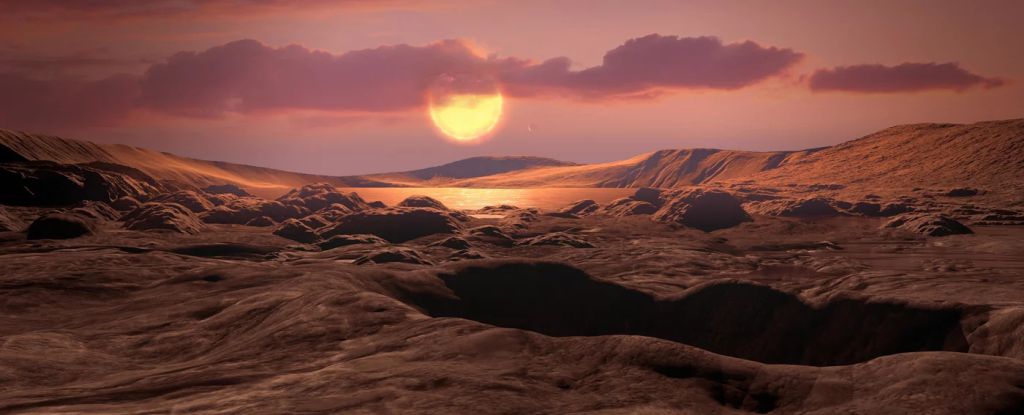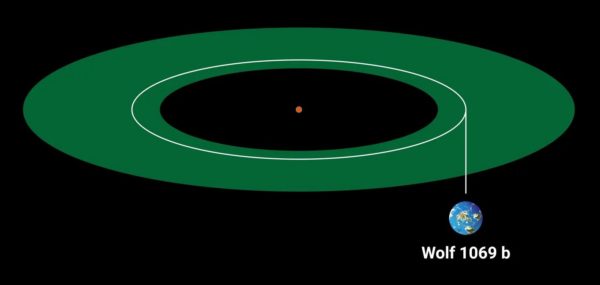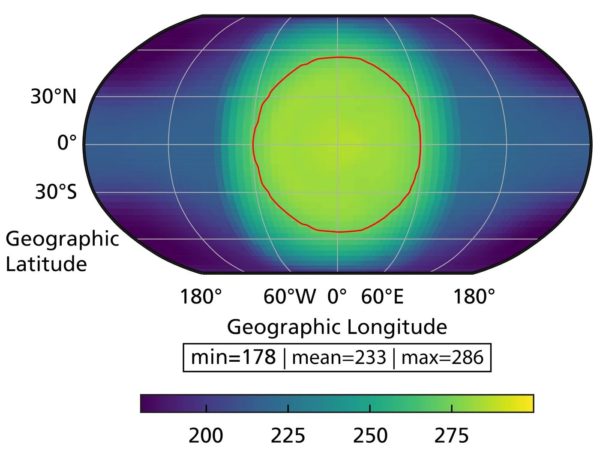
Posted on 02/03/2023 1:22:29 PM PST by Red Badger

An illustration of a the surface of a rocky exoplanet orbiting in the habitable zone of a red dwarf star. (NASA/Ames Research Center/Daniel Rutter)
We have a new exoplanet to one day scour for potential signs of life.
Just 31 light-years away, astronomers have identified an incredibly rare Earth-sized world orbiting at a distance from its star that should be hospitable to life as we know it. If, that is, the exoplanet itself has the right conditions to be conducive to life's emergence.
That information isn't available to us yet, but the world represents a promising candidate for a future search for biosignatures on nearby, Earth-mass exoplanets.
The search for exoplanets – that is, extrasolar planets, those outside our Solar System – is hobbled by the limitations of our current technology. Make no mistake, that technology is amazing; but our primary methods for finding exoplanets are way better at finding large worlds than small ones.
That's because they rely on indirect signs, the effects an exoplanet has on its host star. The transit method detects the very faint, regular dips in starlight as an exoplanet orbits between us and its star; and the radial velocity method detects minute changes in wavelength of light as the star is very, very slightly moved around on the spot by the gravitational interaction with the exoplanet.
So, while more than 5,200 exoplanets have been confirmed at time of writing, fewer than 1.5 percent of those have masses below that of two Earths.
And of those, perhaps a dozen are orbiting their stars at a distance where temperatures could allow for liquid water on the surface – not so hot that it burns off, nor so cold that it freezes.
A location in this so-called habitable zone is the first step in narrowing down whether a world may or may not be hospitable to life. And this is what a team of astronomers led by Diana Kossakowski of the Max Planck Institute for Astronomy (MPIA) in Germany have discovered a nearby red dwarf star Wolf 1069.
The newly discovered exoplanet, 1.36 times the mass of Earth, has been named Wolf 1069b.
"When we analyzed the data of the star Wolf 1069, we discovered a clear, low-amplitude signal of what appears to be a planet of roughly Earth mass," Kossakowski says.
"It orbits the star within 15.6 days at a distance equivalent to one-fifteenth of the separation between the Earth and the Sun."

Illustration showing Wolf 1069b's position in its star's habitable zone, represented by a green ring. (MPIA graphics department/J. Neidel)
That would definitely be too hot for habitability if Wolf 1069 was a star like the Sun, but red dwarfs are much smaller and cooler than our home star. This means that their habitable zones are significantly closer to the star than our Solar System's habitable zone, which just extends from around Venus and just reaches Mars.
Although Wolf 1069b is 15 times closer to its star than Earth is to the Sun, the radiation it receives is around 65 percent of what Earth receives from the Sun.
At this level, a bare, rocky Wolf 1069b similar to Mercury should have a temperature around -23 degrees Celsius (-9.4 degrees Fahrenheit). That's way too cold for liquid water; but, without an atmosphere, liquid water would turn to vapor anyway.
Obviously there's a lot more that goes into habitability than just the right proximity to the star.
An atmosphere could trap heat and lift the average temperature, but it would need to be a nice, thick atmosphere. Mars has an atmosphere, and its mean temperature sits at -65 degrees Celsius.
The red planet's atmosphere is also rather flimsy, and this is thought to be because it doesn't have a protective global magnetic field like Earth does. ( Venus doesn't have an internally generated magnetic field, either, but its interaction with the solar wind creates an external one. It's a Venus thing.)
An internally generated global magnetic field is the result of rotating, convecting, and conducting fluids within the planet's core that converts kinetic energy into magnetic energy to create a magnetic field. And it's possible that Wolf 1069b has one of these.
"Our computer simulations show that about 5 percent of all evolving planetary systems around low-mass stars, such as Wolf 1069, end up with a single detectable planet," says astronomer Remo Burn of the MPIA.
"The simulations also reveal a stage of violent encounters with planetary embryos during the construction of the planetary system, leading to occasional catastrophic impacts."
These encounters would heat the young world, suggesting that the core of Wolf 1069b is still molten, like Earth's core, and therefore could be generating a magnetic field.

Simulated surface temperature map of Wolf 1069b. Liquid water could exist inside the red circle. (Kossakowski et al., A&A, 2023)
There's just one more problem. You know how the same side of the Moon is always facing Earth? That's called tidal locking, and it's the result of gravitational "brakes" being applied to a body's rotation if it's in close orbit with a more massive one.
Because the habitable zone of red dwarf stars is so close to the star, most potentially habitable red dwarf exoplanets are tidally locked. That means one side is in permanent day, and the other in permanent night.
All, however, is not lost. Research shows that such worlds can still be habitable, particularly around the terminator, the twilit line between night and day. A simulated temperature map of Wolf 1069b, however, shows that liquid water is most likely to be present on the region directly facing the star.
Unfortunately, we're going to have to wait to find out more: Wolf 1069b doesn't pass between us and its star, which means we currently have no way of probing it for an atmosphere.
"We'll probably have to wait another ten years for this," Kossakowski says.
"Though it's crucial we develop our facilities considering most of the closest potentially habitable worlds are detected via the radial velocity method only."
The research has been published in Astronomy & Astrophysics.
Wow, 31 light years. Thing’s practically in our hip pocket…relativity speaking.
Vulcan!
If we get started early in the morning we can be there in no time...Especially at the speed of light.
An illustration of a the surface of a rocky exoplanet
Aka
Pretty painting based on imagination
Aka
NOT the surface of ...
/
Astronomers Find What
May
Be a .....
/
should
be hospitable to life as we know it.
...
. If,....
/
That information isn’t available to us yet,
Aka
We pulled this out of our nethers.
/
Our computer simulations show
Aka
GIGO
/
...give us more grant money .
Operative words: “may be”.
sheila jackson lee says we should go there and get our flag back.
Dude! Get in before it gets too crowded.
The most “Earth like” planet ever discovered is almost the same size and mass as Earth and orbits a yellow dwarf star at relatively close to the same orbit as Earth.
It is called Venus. Up close it is not very Earth like.
I suspect that most “Earth like” exoplanets are far more “Venus like” or “Mars like” than they are Earth like.
I'm telling you right now, they dont know diddly squat about what might me!! there is no way in hell their models and guesstimates can tell if a planet is in a orbital zone that would sustain life from 31 MILLION light years away!! Earth has life, Mars does not. and there is only 50 million miles between us!! and can anyone seriously tell me that judging/estimating this, something that would actually compare to a grain of sand against our solar system to 50 Million miles against 31 Million Light Years!! and I think im shy using the grain of sand/solar system example...
smh...
As I recall from one of the few moments in physics class I was awake: at the speed of light, the Enterprise would get there and back in no time, but it would appear to us on Earth that it had taken 32 years.
If the planet is orbiting a red star, does that mean that any life forms that evolve would, automatically, be communists?
Not necessarily, however knowing communists, it wouldn’t
take long. It’s the solution they are working toward
here on earth.
As I recall the Borg took over the Wolf 359 system in a huge battle. Probably best to stay away from that area.
Only 31 light years? Biden probably has his people gearing up for refugee applications as we speak, and NASA will be tasked with bringing them here.
On the bright side, there will at last be a rationale for a manned space program that democrats will support.
Let’s choose the B Ark crew now.
Well yeah but wouldn't the Enterprise have go to warp factor 31 to get there in a year.
Less than a year at Warp Factor 3 according to ST:TNG.
I think we can build a bridge using deficit dollars.
So true. Most people don’t realize how vast are the empty distances between worlds, let alone between solar systems. We are extremely lucky to have a few worlds in our solar system to “play” with. Just getting to the Moon is difficult, let alone going to Venus or Mars - but can be done given enough time and resources. Other worlds will never be as good as Earth, what with our seasons, water, breathable air, and magnetic poles to block radiation. If we could rid ourselves of liberals we wouldn’t need to look elsewhere.
5.88 trillion miles x 31= 182.28 trillion miles. That's all. astronomers have identified an incredibly rare Earth-sized world orbiting at a distance from its star that should be hospitable to life as we know it. If, that is, the exoplanet itself has the right conditions to be conducive to life's emergence.
Taking into account the inconceivable complexity needed for an " Earth-sized world hospitable to life as we know it" than it becomes another example of the great faith of such promoters, yet who usually deny (at the least) that this world had a creator. "Faith-based scientific postulations." If the belief in a universe without a creator - which is what is implied by lack of even the mention of one as a possibility - was a formal religion it would be disallowed in schools, yet even intelligent design is banned due to its religious motivations.
Design from Fine-Tuning | Reasonable Faith
'God: new evidence' - the fine tuning of the universe - part 1
When science and philosophy collide in a 'fine-tuned' universe
We Live in a Very Fortunate Universe
Can DNA Prove the Existence of an Intelligent Designer?
82 Mind-Blowing Facts about DNA | FactRetriever.com To believe that an exceedingly vast, systematically ordered universe, exquisitely finely tuned for life with intricate astounding complexity, can be all a result of purely natural processes requires much faith, more so than that the universe logically testifies to design, requiring a First Cause (at the least), that of a powerful being of supreme intelligence being behind the existence of energy and organization of matter. https://www.quora.com/How-would-you-respond-to-this-argument-Since-science-cannot-prove-or-disprove-the-existence-of-God-then-its-possible-he-exists/answer/Daniel-Hamilton-53 https://freerepublic.com/focus/chat/4125206/posts?page=23#23
Dawkins [essentially] Admits Nothing Can Persuade Him God Exists
It’s Almost Impossible to Understand How Unfathomably Massive Our Universe Truly Is
The place is probably crawling with Xenomorphs.
Disclaimer: Opinions posted on Free Republic are those of the individual posters and do not necessarily represent the opinion of Free Republic or its management. All materials posted herein are protected by copyright law and the exemption for fair use of copyrighted works.